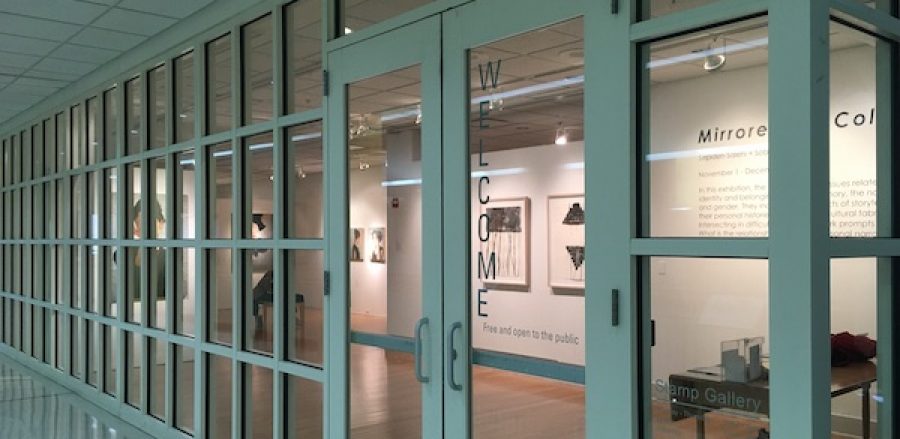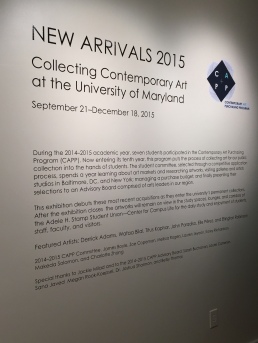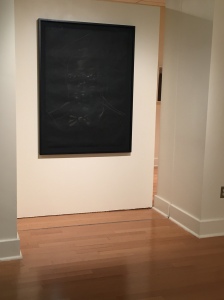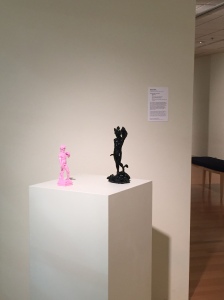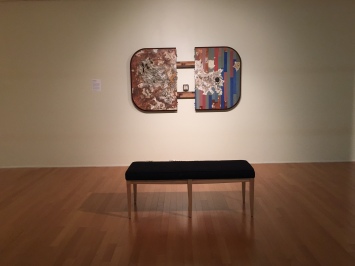Installation Revelation
Posted: September 23, 2015 Filed under: Contemporary Art Purchasing Program (CAPP), Opening Reception | Tags: art, Contemporary Art, Contemporary Art Purchasing Program, ellington robinson, installation, race, stamp gallery, Stamp Student Union, stamp union, titus kaphar, UMD, University of Maryland, wafaa bilal 1 CommentSo you’re walking by the Stamp Gallery one afternoon. Peaking through the glass exterior, you see that there are boxes and packing paper scattered throughout. You see some power tools on the benches, and a ladder leaning against the corner. You notice random walls that seem to be hanging out in limbo in the middle of the space. Walking past the entrance, you find a sign taped to the door: “Closed for installation, please come back for our opening next week!”
Ever wanted to know just what goes into the installation of a gallery exhibition?
The past week at the Stamp Gallery has been quite a busy one, with the installation of our current exhibition featuring new arrivals for the Contemporary Art Purchasing Program (CAPP). As a docent, I get to take part in this installation process. As such, I thought I’d offer a little glimpse into a few of the more subtle, never-occurred-to-me-before-I-started-working-here types of things that go on behind the scenes of an installation.
Vinyl
When you first walk into the Stamp Gallery and start reading about what the exhibit is about, you are reading the vinyl. I’d like to start off by admitting that, before I started working at the gallery, I was under the impression that someone had to come and actually hand-paint the words onto the wall…which I’m glad is not the case! After the exhibition overview is typed up in a Word doc, it is sent to be blown up in size and then printed out on a kind of sticker-like paper. Before sticking this onto the wall, we measure the length/width of the sheet, take a ruler to the wall, level it, and make light pencil marks for guidelines. Next, we peel off the outer layer of the sheet, which uncovers the sticky part that goes onto the wall. Once we have the sheet up on the wall, we smooth out any wrinkles and press it against the wall as much as possible – this makes it easier to peel the paper off without peeling the actual letters off as well. The final step is to do the actual peeling!
Walls
In the gallery, we have “moveable” walls that are stored in the back. The wall holding Titus Kaphar’s The Jerome Project (Asphalt and Chalk) XII is a moveable wall.
These walls allow us the mobility to create new, smaller spaces within our existing gallery space. They also provide extra surface area to accommodate more pieces, draw attention to particular works, as well as provide general interest and variability to the eye. For this exhibition in particular, we added a wall behind the podium holding Wafaa Bilal’s Perseus Beheading Medusa and Pink David in order to direct focus onto the pieces, since they are relatively small objects in comparison to the space.
Lighting
Tracks along the ceiling of the gallery provide grooves that the lights hook into. There are three tracks spanning the length of the space, and five tracks running widthwise. The lights themselves consist of a bulb attached to a frame that can be maneuvered to adjust the angle of the light accordingly. In addition, there are metal bars within the hook of the frame that conduct electricity and make the light turn on when attached to the track. Depending on the needs of the exhibition/pieces, the lights can be placed so that they either “spotlight” or provide a softer, glow to the work. When spotlighting, the lights are generally placed closer to the piece, which provides a very direct focus. Setting the light farther back creates more of an atmosphere and harmonization for the piece as well as the space surrounding it. Other things to keep in mind when setting up lights is reflection, shadows, and the color casted by the bulb. For the pieces that contain a glass covering, we had to consider the effects of possible reflections caused by our lighting choices. In addition, we can control the degree and location of shadows by light placement. For Ellington Robinson’s Oath of the Imperialists, we played around with the distance of the lights from the work in order to “shift” the shadows around.
Finally, some bulbs are older than others and cast a softer, more yellow hue than the newer ones, which typically cast a very bright, verging on greenish tint. We usually try to match the shades of light throughout the exhibit.
Of course, there are many other aspects that go into a gallery installation that I haven’t mentioned here – each show is unique in terms of the methods used to bring it together. For a closer look at the results of our installation, be sure to check out the opening reception of CAPP New Arrivals 2015 this Friday, September 25th between 6-10pm.
See you there!
Carmen Dodl
